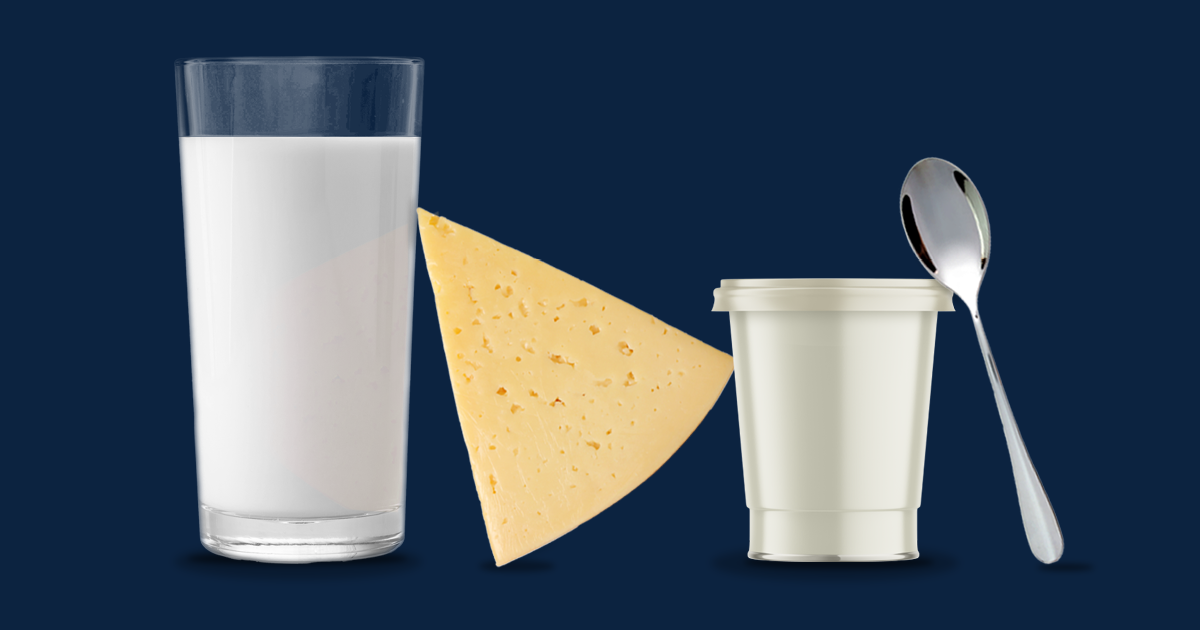
Type 2 diabetes
Food choices can affect the risk of developing type 2 diabetes. The Australian Dietary Guidelines recommend consumption of a wide variety of nutritious foods from the five food groups every day. Some of these foods, such as milk, cheese and yoghurt have even been linked to a reduced risk of developing type 2 diabetes.1
The role of dairy in preventing type 2 diabetes
Both reduced-fat and regular-fat milk, cheese and yoghurt are not linked with development of type 2 diabetes. In fact, a higher overall dairy intake may be protective against type 2 diabetes. A meta-analysis published in 2014 reviewed 14 studies in relation to dairy food consumption and risk of type 2 diabetes.2 All types of dairy were not associated with development of type 2 diabetes, while yoghurt consumption was associated with an 18% reduced risk of type 2 diabetes development.
A further review looking at 16 separate studies and over 520,000 people found higher intakes of all varieties of milk, cheese and yoghurt was linked to an 11% reduction in the risk of type 2 diabetes, compared to people eating fewer dairy foods.3 Every 200 grams of total dairy foods was linked to a 6% reduction in type 2 diabetes risk. A 20% drop in the risk of type 2 diabetes was reported for every 30 grams of cheese consumed per day.
In regards to mechanisms, it is likely that the calcium, vitamin D, protein and magnesium found in dairy foods may beneficially modulate insulin responses.4 There is also evidence to show certain fatty acids present in dairy foods, including pentadecanoic acid (15:0) may have a beneficial role in the prevention of type 2 diabetes.5
Dairy and weight management in type 2 diabetes
Reducing excess body weight, particularly from the waist, reduces the risk of developing type 2 diabetes and makes the condition easier to manage in those who have already developed it. Dairy foods are often thought to be associated with weight gain, despite consistent evidence showing the opposite.6 Some health professionals are therefore reluctant to advise increased consumption of dairy foods to people at risk of, or with, type 2 diabetes. However the consumption of milk, cheese and yoghurt may assist with weight management and reduce waistlines when part of a balanced diet.7
Most Australians need to increase their intake of milk, yoghurt, cheese and/or alternatives (mostly reduced-fat).8 Advice to switch from regular to reduced-fat dairy could lead to an overall reduction in dairy intake, meaning Australians are missing out on the unique package of nutrients and associated health benefits dairy provides.
Dietary management of type 2 diabetes
Dairy foods such as milk, cheese and yoghurt can play an important role in managing type 2 diabetes. Milk and yoghurt have a low glycaemic index (GI) so are ideal for people with diabetes. Low GI foods help prevent large ‘ups and downs’ of blood sugar levels. They are more slowly digested, absorbed and metabolised, increasing feelings of fullness and reducing feelings of hunger.
Carbohydrate containing dairy foods such as milk and yoghurt are ideal low GI foods due to the combination of their carbohydrate source (lactose) having a naturally low GI, and the presence of protein which helps slow the release of glucose into the bloodstream. A study showed a low GI diet high in dairy foods and fruit, but low in potatoes and cereals improved insulin sensitivity in adults 65 years and over.9 Cheese is also low GI, explained by its lower levels of carbohydrate and higher fat and protein content.
Visit the home of the glycaemic index to learn more about the GI of different foods.
Type 2 diabetes resources
Audio clip
Accredited Practising Dietitian Sharon Curtain discusses why keeping good foods in the diet can help people better manage health risks such as type 2 diabetes.
Type 2 diabetes fact sheets
Download the Type 2 diabetes fact sheet
Download the Healthy weight fact sheet
Download the Pre-diabetes management guide
1 National Health and Medical Research Council. Australian Dietary Guidelines, Canberra: Commonwealth of Australia; 2013.
2 Chen, M. Dairy consumption and risk of type 2 diabetes: 3 cohorts of US adults and an updated meta-analysis.BMC Med. 2014;12:215.
3 Gao D, Ning N, Wang C, Wang Y, Li Q, Meng Z et al. Dairy products consumption and risk of type 2 diabetes: systematic review and dose-response meta-analysis. PLoS ONE. 2013;8(9):e73965.
4 Aune D, Norat, T, Romundstad, P, Vatten. Dairy products and the risk of type 2 diabetes: a systematic review and dose-response meta-analysis of cohort studies. Am J Clin Nutr. 2013;98:1066-83.
5 Forouhi NG, Koulman A, Sharp S, Imamra F, Kroger J, Schulze MB et al. Differences in the prospective association between individual plasma phospholipid saturated fatty acids and incident type 2 diabetes: the EPIC-InterAct case-cohort study. Lancet Diabetes Endocrinol. 2014;2:810-18.
6 Chen M, Pan A, Malik V, Hu F. Effects of dairy intake on body weight and fat: a meta-analysis of randomized controlled trials. Am J of Clin Nutr. 2012;96(4):735-47.
7 Abargouei A, Janghorbani M, Salehi-Marzijarani M, Esmaillzadeh A. Effect of dairy consumption on weight and body composition in adults: a systematic review and meta-analysis of randomized controlled clinical trials. Int J Obes Relat Metab Disord. 2012;36(12):1485-93.
8 Doidge JC, Segal L. Most Australians do not meet recommendations for dairy consumption: findings of a new technique to analyse nutrition surveys. Aust N Z J Pub Health. 2012;36(3):236-40.
9 Du H, van der ADL, van Bakel MM, van der Kaellen CJ, Blaak EE, van Greevenbroek MM et al. Glycemic index and glycemic load in relation to food and nutrient intake and metabolic risk factors in a Dutch population. Am. J Clin. Nutr. 2008;87: 655-61.

